| Driving
Distractions Take
Their Toll Cell Phones and Other Distractions Contribute to Accidents |  |
| Driving
Distractions Take
Their Toll Cell Phones and Other Distractions Contribute to Accidents |  |
|
By Ellen Kuwana Neuroscience for Kids Staff Writer  December 20, 2004
December 20, 2004I think it's fair to say people in the US are obsessed with multi-tasking. Many job descriptions list multi-tasking as one of the requirements. Parents have to multi-task. So many activities fill our lives that multi-tasking seems like a matter of survival. What does brain research tell us about multi-tasking?
Scientists can view the working brain using functional magnetic resonance imaging (MRI). Studies have
shown that while multi-tasking, a person's brain does not function as well
as if the person were doing the tasks separately. It actually takes us
longer to complete tasks when we multi-task; any gain in efficiency is
just an illusion.
Yet we multi-task all day, especially when driving. We drive, talk on cell phones, listen to music, attend to kids in the back seat, apply make-up, eat food, drink coffee and plan our days -- all at the same time! We forget that driving itself is a multi-tasking job that involves high-level thinking: hand-eye coordination (steering), decision-making (lane changing), visual information analysis (where are the lane lines), spatial processing (how far away is the curb?) and judgment about relative speeds of nearby vehicles (can I change lanes safely?). Driving is also something we do regularly, without much conscious thought. All this activity inside a vehicle weighing two tons and zipping along at 25-65 miles per hour.
One of out four accidents caused by "inattentive" driverDrivers who are doing other tasks are more likely to have an accident. Inattentive drivers contribute to at least 25% of accidents, according to the National Highway Traffic Safety Administration. This equates to 1.2 million accidents each year caused by distracted drivers. The American Automobile Association (AAA) estimates that 1.5% of distracted driver accidents were attributable to cell phone use (compared to 10.8% caused by other occupants causing a distraction; 11.4% to adjusting the music). A driver who inserts a music CD increases the likelihood of an accident by six times as compared to glancing at the fuel gauge. So if cell phone use causes fewer accidents than fiddling with the radio, why are cell phones getting much of the blame? For one thing, it's a distraction that is easier for other drivers to spot. It's easy to blame another driver if he or she is on a cell phone. And cell phone use is becoming more and more common; it's a visible distraction.Surveys indicate that half of all drivers use their cell phones while driving. A 1997 study in Toronto, Canada, found that using a cell phone while driving increased the risk of a collision by four times during the "brief period of a call." And these drivers are not just a threat to themselves -- they are a threat to everyone's safety. Two states (New York and New Jersey in 2001) and Washington, DC (in 2004) so far have banned cell phone use for drivers.
The bottom line is that there is no way to make cell phone use 100% safe for drivers; the very action of talking diverts attention from the road. So keep your eyes and mind on the road and devote 100% of your attention to driving.
|
Did You Know?
|
|
References and further information:
|
| GO TO: | Neuroscience In The News | Explore the Nervous System | Table of Contents |
![[email]](./gif/menue.gif) Send E-mail |
 Fill out survey |
 Get Newsletter |
 Search Pages |